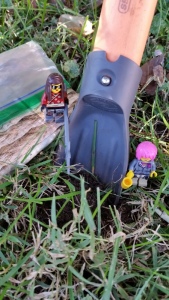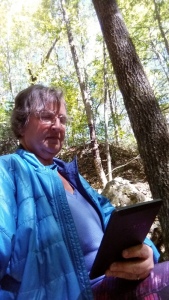Like everyone, we have had many challenges in life. Through counseling, comfort from God, and encouragement from others, we have learned how to walk through difficult things. It is always inspiring when we can pass these blessings on to others we meet who are struggling.
God comforts us in all our troubles so that we can comfort others who are also suffering. — 2 Corinthians 1:4
As I’ve mentioned previously, our most recent AT adventure was very hard emotionally. Both daughter and I wanted to quit multiple times. Looking back, I realize we would have missed opportunities to bless others and to receive blessings if we had given in to those negative emotions and left the trail early. Here are stories of blessings which occurred after our breakdown moments:
Daughter Andowen has worked with a therapist for many years to gain coping skills to deal with severe anxiety and suicidal ideation. A key technique is “reframing” negative thoughts. One afternoon at a shelter, Elizabeth* shared her struggles with debilitating anxiety and panic attacks. Before I could say anything, Andowen jumped in and talked about how significant reframing has been for her. She explained the process step by step. It was exciting for me to see my teen daughter teach her hard-earned coping skills to an older adult. 
Another day, some first time backpackers showed up at a shelter we were at for a night. They were tired and discouraged. They were baffled as they tried to set up their new tent and use their fancy stove—things they had neglected to practice before leaving for the trail. Andowen went over to introduce herself, and then proceeded to calmly teach them how to use their gear. When I wandered over a little later, they raved about how helpful Andowen was, how wonderful it was that she was so skilled in the woods, and how grateful they were. Because of her encouragement, they said they plan to return to the trail for more adventures in the future. Way to go, Andowen! 
One night another hiker and I stayed up late, talking about some of the profound challenges our kids face. David* shared his heartbreak that his young adult son was often in self-inflicted crisis. As is often the case, the anonymity of sitting with a stranger around a campfire allowed deep sharing. I mostly listened, occasionally encouraging David with stories from our family’s life. The next morning, I grabbed a private moment to explain what I’ve learned about grief. We can’t help others or dream of new things until we recognize and acknowledge challenges, and then grieve losses and disappointments. This process allows us to truly accept present realities even as we hope for change. Sharing these things with David reminded me of the progress we have made in our family…and sent him on his way, pondering how these ideas could begin to heal his own broken heart. 
Twice on this trip, we were able to attend local church services. Both times, we were accepted, prayed for, and encouraged. Both times, it felt like some of the teachings were exactly the words we needed to hear. God used the people in those little churches to bless us as we headed further down the trail. At the same time, in both settings, the congregations were facing challenges that we have had experience with. I was able to privately encourage leaders by telling stories about what God has done in our own lives in similar situations. Warren Wiersbe, a noted theologian says, “True worship should lead to…the kind of spiritual strength that helps the believer carry the burdens and fight the battles of life.” In these little small town churches, we experienced the mutual blessing of true worship! 
Sometimes being blessed and blessing others takes far less effort. Small words can echo for days: “I love spending time with your daughter.” “You have the most beautiful eyes, so full of life.” “You are doing a good job, mama. Keep it up!” Simple actions can encourage: “I picked up two wild apples, would you like one?” “I’ve got some extra water, do you need it?” “This is a tough spot. I waited to give you a hand, if you want…” When we stopped for rest-breaks, I often found myself remembering these little kindnesses. 
Occasionally I am reminded of the importance of bravely sharing the lessons we learn as we walk through dark places. We never know where those bits of light might shine. After writing a blog post about “Hard Days” (you can read it HERE), a friend across the country told me the following story: Stephanie* volunteers monthly at an outreach for homeless people in her town. She found herself listening as one man poured out his desperation, telling her of his plans to kill himself after he left the park, too discouraged to reach out again for help that never changed anything. Stephanie grew more and more upset as she struggled to find any words to respond. Suddenly she remembered the closing words from my blog post that morning. When she told the man “Never quit on a bad day,” he burst into tears, and then allowed her to get him to a psychiatric emergency room where he checked himself in for treatment. Wow! 
As we in American have just finished Thanksgiving Day, it is a good time for all of us to ponder: How have I been helped in my own life, especially as I have walked through hard things? But let’s not just stop with gratitude for ways we have been blessed. Let’s start a chain of encouragement as we pass those blessings on to others!
*These stories really happened, but names have been changed to protect the privacy of individuals.





































































